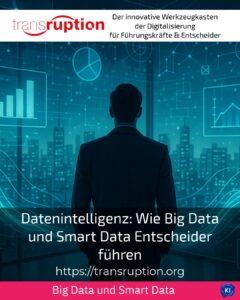In the digital age, companies are swimming in a flood of information. Millions of data points are generated every day from a wide variety of sources. But mass does not equal benefit. This is where the concept of data intelligence comes into play. Data intelligence describes the ability to filter out the right information from this huge amount of data and convert it into usable knowledge. [1] This allows you to support your decisions with precise, relevant and timely insights instead of mere assumptions. 5]
Understanding the difference between big data and smart data
Big data is huge amounts of unstructured raw data from numerous sources. [11] In a modern retail group, millions of transaction data records are created every day. A manufacturer continuously collects sensor data from production. A financial services provider constantly processes customer interaction data. All of this is big data, i.e. raw data in unfiltered form.
Smart data, on the other hand, are intelligent, processed data records. They have been filtered, consolidated and validated. [3] From the millions of transaction data of a retail group, you extract specific information that shows the purchasing behaviour of certain customer groups. This is smart data. It offers direct added value for specific business issues.
The formula is simple: big data plus benefits plus semantics plus data quality plus security equals smart data. [1] Big data is the raw material. Smart data is the refined product. The decisive difference lies in the intelligent processing.
Why data intelligence is critical for your decisions
Data intelligence combines big data and smart data into a strategic force. [5] It enables you to make better decisions faster. A retail company uses data intelligence to optimise stock levels. An energy supplier uses it to plan network utilisation. An insurance company uses it to identify attempted fraud at an early stage[11].
The challenge is real: many decision-makers feel overwhelmed by the amount of data. They have access to hundreds of reports and dashboards. But what information is really relevant to the current business issue? This is exactly where data intelligence comes in,[13] filtering out the superfluous and emphasising the essential.
Data intelligence in practical application
The use cases are diverse and cross-industry. Data intelligence supports decision support, predictive maintenance, misuse detection, logistics optimisation and process analysis. [4]
Example 1: Industry 4.0 and data intelligence
A machine manufacturer continuously collects sensor data from its production systems. This raw data is a massive amount of data. Data intelligence is used to analyse and process this data. The system identifies patterns that indicate an impending failure. [13] Maintenance teams can thus act proactively instead of reacting to failures. The financial impact is considerable: unplanned downtime costs time and money. Data intelligence helps to avoid them.
BEST PRACTICE at the customer (name hidden due to NDA contract)A leading manufacturer of production machines uses data intelligence to optimise its maintenance planning. The company processed daily sensor data from over a thousand machines installed at customers worldwide. Through intelligent data analysis, it was able to predict failure patterns and inform customer service when maintenance was required. This led to a reduction in unplanned downtime of around forty per cent and significantly increased customer satisfaction. At the same time, the company optimised its service resources, thereby reducing operating costs.
Example 2: Financial sector and fraud detection
Banks and insurers process millions of transactions every day. Big data is unavoidable here. Data intelligence is used to recognise suspicious transaction patterns. [13] Machine learning algorithms learn what normal transactions are and what anomalies occur. This enables fraud attempts to be recognised promptly before damage can occur. The data quality and accuracy of these systems is crucial.
Example 3: Retail and customer segmentation
A large retail chain collects data on millions of customer interactions every month. Online purchases, store visits, returns, reviews. That's a huge amount of data. Data intelligence helps to transform this data into meaningful customer segments. [6] Marketing can then create personalised campaigns for specific customer groups. The results are more measurable and efficient than generalised mass marketing.
The technologies behind data intelligence
Data intelligence is not a single technology, but a combination of several modern systems. [2] The most important components are
Artificial intelligence and machine learning
AI systems automatically recognise patterns in large amounts of data. Machine learning models train themselves on the basis of data and are becoming increasingly precise in the process. An e-commerce company uses AI to predict the next purchase intentions based on browsing behaviour. An energy supplier uses machine learning to forecast demand trends. [2] These technologies are the engines behind intelligent data processing.
Data consolidation and data quality
Before data can be analysed, it must be merged. [9] An insurance group has stored customer data in three different systems. Data consolidation unites these in a standardised structure. Data quality checks identify errors and duplicates. An entry with the wrong postcode, a missing name, duplicate customer numbers. These are corrected. This is the only way to create smart data that you can rely on.
Automation of data processing
Many manual processes can be automated with data intelligence. [2] A logistics company used to have to manually check and analyse hundreds of reports every day. Today, this analysis is automated. The systems automatically filter the data that indicates supply chain delays. The result is available more quickly and is more error-free.
How data intelligence supports concrete decisions
The practical use of data intelligence for decision-making follows clear patterns. First, the business question is defined. What do you want to know? Should growth be increased, costs reduced, risks recognised?[11] Then the relevant data sources are identified. Where does the information that answers this question originate?
A software company wants to understand why certain customer groups are cancelling. That is the business question. Relevant data sources are customer profiles, usage data, support tickets, payment history. This data is consolidated, cleansed and analysed. Smart Data shows: Customers with problems in Feature X cancel more frequently. The first hour after support contact is critical. Customer group Y shows different cancellation patterns than group Z. These insights are gold for strategic decisions. You can now take measures that actually help.
Clients often report that data-intelligent analyses make their decisions faster and more informed. [5] They need less time for manual research. They have greater confidence in their data. They can take advantage of opportunities at an early stage and recognise risks early on.
Step-by-step: Implementation of data intelligence
The implementation of data intelligence is a process, not a single project. [9] The first step is to analyse the origin of the data. Where does your valuable data originate? On the production floor? In the customer database? On the digital platform?[11]
The second step is target definition. Which specific business questions should be answered? This is not trivial. Many companies start too vaguely. It is best to formulate three to five very specific questions.
The third step is technology selection. Which platforms and tools fit your requirements? Big data platforms such as Hadoop or Spark, combined with smart data analyses and AI models. [11]
The fourth step is data quality assurance. Reliability is the foundation. Only correct, complete and up-to-date data leads to reliable results. [11]
The fifth step is communication. Data intelligence must be translated into understandable impulses for action. A report with a hundred pages of statistical details is of no use to the decision-maker. Concise visualisations and clear recommendations are valuable. [14]
Practical tips for successful data intelligence
Start with questions, not data. Clear business questions lead to better analyses than the idea of having to analyse all the data.
Rely on intelligent data integration that brings together and cleanses different sources. This is the basis for smart data.
Use algorithms in a targeted manner. Avoid providing too much information. Not all data is relevant for every question.
Pay attention to data protection and compliance. Data intelligence must be ethical and legally compliant.
Promote a corporate culture that supports data-based decisions. This is more important in the long term than individual tools.
Data intelligence as a competitive advantage
In the digital age, data intelligence is no longer a luxury, but a necessity. [8] Companies that use big data intelligently gain strategic advantages. They make faster decisions. They act instead of reacting. They recognise opportunities earlier than their competitors.
A retail chain uses data intelligence for product range planning. The competition plans according to gut feeling. Who wins? A logistics company optimises routes using smart data. The competition uses empirical values. Who is more cost-efficient? A financial services provider recognises fraud patterns using AI. The competition needs days for manual checks. Who protects their customers better?
Data intelligence is therefore not just a technical issue, but a strategic one. [13] It has an impact on competitiveness, profitability and innovative strength.
Frequent challenges during implementation
The implementation of data intelligence is not without its hurdles. The first challenge is a lack of data culture. Many organisations have data, but do not use it strategically.
The second challenge is a lack of quality. Raw data is often incomplete, incorrect or outdated. They must first be cleaned up.
The third challenge is silo thinking. Data is located in different departments, different systems and different formats. Integration is complex.
The fourth challenge is the lack of talent. Data scientists and analysts are in demand and in short supply on the market.
But each of these challenges can be solved. With clear goals, good planning and the right partner, you can successfully utilise data intelligence.
My analysis
Data intelligence is the key to better decisions in a data-rich world. [1][5][13] It transforms big data from an overload into a competitive advantage. The combina














